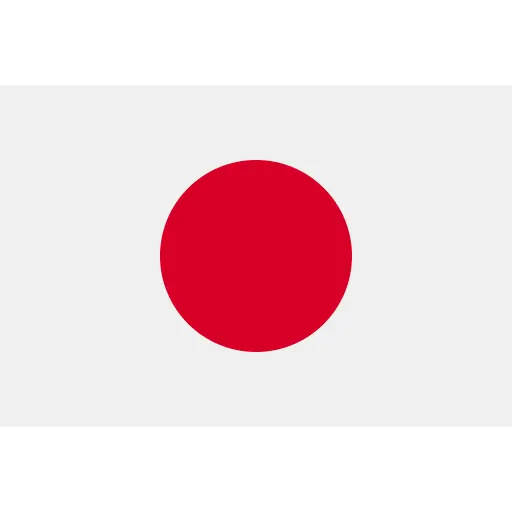5 cities you must visit in Japan
Are you missing a few tips on where to make a pit stop on your trip around Japan? So we've put together a nice little guide to which Japanese cities you simply MUST experience and explore on your trip. We have already written a guide to where to go in Tōkyō, so the Japanese capital is not included in the guide. You can read our guide to Tōkyō right here .
Top 5 Japanese cities
In my eyes, Japan is a country that everyone should visit at least once in their life, because there really is something for everyone. Japan is the fusion of traditional and high-tech and everything in between, and here you'll find everything from robot cafes and colorful neon advertisements to bamboo forests and ancient mountaintop temples. There's no place on earth like Japan, but it's certainly not just Tōkyō where things happen. There are also experiences for everyone in eastern Japan, Kansai, and Hokkaido. Anyways, herewith a small guide to our top 5 cities in Japan.

(https://unsplash.com/photos/Xq1ntWruZQI)
1. Osaka
Japan's second largest city with over 19 million. residents are Ōsaka. Here in the city, people speak Ōsaka ben or Kansai ben ( ben means dialect), and they speak a little differently than in Kantō, where Tōkyō is located. For example, many people say " meccha ", which means "a lot", instead of " totemo" in standard Japanese. Therefore, you may just have to get used to the fact that some words are not quite the same here. But whatever the dialect here, in Ōsaka there are at least good opportunities to go to an izakaya , eat delicious food or see one of the many sights.
Ōsaka is perhaps best known for its beautiful castle Ōsaka jō from the 16th century. It costs around ¥600 (approx. DKK 35) to enter the castle itself, but it is also quite beautiful from the outside. There is an opportunity to buy a souvenir or take a walk in the beautiful garden close to the castle, where already in January or February you may be lucky enough to see the plum trees in bloom.
Another iconic landmark in the city is the running neon man from 1935, the Glico Man, made by the company Glico, behind the iconic long snack Pocky. The running man stands on the famous shopping street by the Dōtonbori River. Here you will also find fantastic street food , and you can e.g. sink your teeth into delicious takoyaki (a kind of Japanese apple slice with squid) or yakisoba (fried soba with meat and vegetables). Ōsaka is truly known to be a mecca for foodies and has many specialties. If you want to try making food as delicious as in Ōsaka yourself, you can try our recipe for Japanese food pancakes with cabbage, okonomiyaki , in true Ōsaka fashion here .
Get a great view of Ōsaka from the Umeda Sky Building , where you can almost see the city of Kobe. The tall building is located at Ōsaka's central station, Umeda, where you can also find Ōsaka's Pokemon Center and several huge shopping malls. Also experience the 80s-esque tower, Tsutenkaku Tower , and the surrounding area Shinsekai , which guarantees the feeling of nostalgia. It is worth visiting this place in the evening, where lamps and neon lights light up everything in beautiful colors. Taste deep-fried kushikatsu , for which the area is famous, at one of the small restaurants.
On a rainy day, you might be more inclined to visit the Cup Noodles Museum Ōsaka Ikeda to learn more about the origins of the cup noodle. Here you can also design your own cup noodles both in terms of packaging and taste. Maybe you'd rather go to Ōsaka Aquarium Kaiyukan . Here you have, among other things, could see a huge whale shark swimming around in the main pool and luminescent fish and whales. It is my impression that the animals here are doing really well compared to many other Japanese zoos and aquariums, so you can confidently support the aquarium with a visit. Not far from the aquarium is the large Tempozan Ferris wheel and Universal Studios Japan . If you are a Harry Potter fan, this is a must see in my eyes. Ōsaka also offers the impressive Shitennōji temple , which is one of Japan's oldest of its kind.


2. Nara
If you want to get away from the hectic city life of Ōsaka, you should take a trip to the small, cozy, traditional Japanese town of Nara (which is actually Mads' mother's hometown). One of the highlights for tourists here in the city are the free-roaming deer , which feel as normal a sight as humans. The deer, sika, are said to be sacred due to an ancient Shinto legend, and it is actually highly illegal to kill the sika. You can get close to the animals and feed them sika senbei biscuits, but be careful with your food and other belongings, because they are not shy. They can become almost completely aggressive if they don't get your biscuits :-)
There is a good opportunity to grab a souvenir with a Nara-sika on the way up to the ancient Buddhist Tōdaiji temple through Nara Park and the Nandaimon gate . The large Buddhist temple was constructed in the 7th century, like many other buildings in the city, when Nara had the title of Imperial City for a while. In the temple's main building you will find the huge Daibutsu Buddha statue, which is one of Japan's largest bronze figures.
If you continue up Mount Wakakusa, you will come to the Shinto shrine Kasuga Taisha . The shrine is especially known for its thousands of stone lanterns leading up to the temple. You will also find a museum and a botanical garden, which, in my eyes, cannot compare to the rustic beauty of the sanctuary. On the way down, you should also take a detour past Kōfukuji temple with its beautiful pagoda and walk through the narrow, tourist-oriented pedestrian streets of Nara city , before continuing to another former imperial city, Kyoto.
 (https://unsplash.com/photos/tEOhkLuqmUI)
(https://unsplash.com/photos/tEOhkLuqmUI)
3. Kyoto
In the late 7th century, Kyōto, which is not far from Ōsaka, became the new imperial city. Because of all the ancient, well-preserved beauties of buildings, it is recommended to set aside a little more days in Kyoto than in Nara. In Kyoto, a Buddhist or Shinto temple appears almost every time you turn a street corner.
The easiest way to get around Kyoto's attractions is by bus. At tourist centers it is possible to buy a Bus One Day-Pass with free access to Kyoto's city buses for ¥900 (approx. DKK 50) . You can read more about it here . The city is generally very tourist-friendly, and the people of Kyoto are very proud of their city's history as a former capital over the centuries. Therefore, it is a nice easy city to be a tourist in.
One of the most famous places in Kyoto has to be the Shinto shrine Fushimi Inari Taisha with its thousand red torii gates. The tourist attraction is dedicated to the deity of rice, Inari, and all the red gates are donated by companies and individuals. Of the Buddhist temples, you will find the beautiful gold-plated Kinkakuji temple . There is also a "silver temple", Ginkakuji , which is a Zen temple with a beautiful Zen garden, so be careful not to confuse the two. Close to Ginkakuji you will also find the Philosopher's Path , which turns completely pink with sakura in the spring.
There are also a few beautiful historical buildings such as the Kyoto Imperial Palace. The magnificent palace was inhabited by the imperial family until 1868, when the capital moved to Tōkyō. You can go on a guided tour around the large garden and come in and see some of the buildings. Remember to book an appointment at the small administrative office next door (it costs free). While Kyōto was still the capital, Nijō Castle was used by the Japanese shogun. Learn more about Japan's political history here at the castle - there are many exciting stories to hear here, such as the one about the ninja floor!
In the eastern part of the city you will find the beautiful temple Kiyomizu-dera , which you will find by walking through narrow, fine streets with stalls. Don't miss a stunning view of the city's rooftops from the top of Mt. Otowa. Close to this temple down in the city is the geisha area of Gion by Shirakawa, where you may be lucky enough to see a real geisha or just one of many women dressed in kimono and traditional make-up to get a few great photos taken. Here in the area you can also try to participate in a traditional tea ceremony or taste one of the area's specialties in the small shops. If you move down towards the city towards Kawaramachi and the covered shopping street, you will find it approx. 400-year-old Nishiki Market , where all kinds of Japanese food and fish are sold.
If you are more into nature, I can recommend a trip to the mountain Arashiyama. In Arashiyama Money Park , which is a large area park with wild monkeys. On the same mountain you will also find the bamboo forest , which is known from Instagram. There are various nice routes in and out of the forest, and you can e.g. enter at Tenryūji Temple. Yes, there is a lot to see in Kyoto and I could go on :-)


4. Hiroshima
Most people are familiar with Hiroshima's role during World War II, and because of the atomic bomb, the city is today a proud city of peace. Perhaps you know the story of the little girl with the thousand paper strands? At least you can learn more about that at the Hiroshima Peace Memorial Museum . It only costs around a flat 10 to get in, and although there are some gruesome details, it's nonetheless an important and thought-provoking visit. Afterwards, you can take a walk in the surrounding peace park or see the Atomic Bomb Dome , which has been left behind so that visitors to the city can experience the effects of an atomic bomb with their own eyes. It should be said that because the atomic bomb dropped above the ground, the level of radioactivity is completely normal, and you can easily visit Hiroshima today without worry.
Hiroshima has not always been a city of peace, and back in the 16th century Hiroshima was a city of castles and fortresses. Hiroshimajō is a central one of its kind with a moat and associated shrine. Here, from the top of the reconstructed castle, you get a great view over the city. When you're done here, take a trip through Hiroshima on an old-fashioned tram . However, it's a little tricky with trams, and I actually can't remember whether you had to pay inside or after.
If you are staying several days in Hiroshima or just want to see something completely different, I would strongly recommend taking a trip by ferry to the island of Miyajima - it really is a must ! And it is no less good to visit the island in autumn, when the leaves are completely red and beautiful. On Miyajima, like in Nara, there are free-roaming deer and temples. In addition, there is a beautiful, traditional red torii gate in the water off Itsukushima Shrine. This is a popular place to get married, so you might spot a couple in traditional Japanese wedding attire - if not, at least you might spot deer. Take a beautiful tour around the island up to Daishōin Temple or continue up to the top of Mt. Misen . On the small island there is also an aquarium and a historical museum.
But you are in Hiroshima or on Miyajima, I would recommend trying a local snack like momiji manjū (Japanese cake shaped like a maple leaf), local oyster (eg with mochi rice cake around) or true Hiroshima style okonomiyaki . If you want to make your own okonomiyaki , we have a recipe right here .


(https://unsplash.com/photos/1Qye5Rv0bNo + https://unsplash.com/photos/WNBNTbFi8pk)
5. Sapporo
We leave the main island and travel north to the island of Hokkaido. Here, Sapporo is the island's "capital" and Japan's fifth largest city. Historically, Hokkaido was inhabited by the Ainu people but has been growing rapidly since the 19th century and is therefore a relatively modern city today. You can learn more about the city's history and Ainu culture at the open-air museum Historic Village of Hokkaido .
Sapporo is probably most popular in the winter, where there are unrivaled ski resorts at e.g. Niseko Ski Resort , world-renowned for fantastic powder snow. From the ski resort you also have a direct view of the beautiful volcano Mt. Yōtei . In addition to the ski resorts, it is also worth going to Sapporo for the Sapporo Snow Festival , where you can experience giant snow and ice sculptures and ice-related activities such as skating and tobogganing in Odori Park.
Today, Sapporo is a big city with its tower, the Sapporo TV Tower , in the heart of the city and the Susukino entertainment district with several thousand bars and restaurants. Sapporo is known for its delicious sea food, and you have the opportunity to taste it yourself at Nijō Market in the central part of the city. Try e.g. a donburi rice bowl with all kinds of fish or sea urchin. If you're not into fish, you can go further to try one of the city's specialties - miso-based Sapporo ramen together with a local Sapporo beer. You also have the opportunity to go beer tasting at the Sapporo Beer Museum and learn more about the beer brand from Hokkaido.
Of other experiences for the whole family, we have the European-looking Shiroi Koibito Park . The park is named after some small Japanese cakes, Shiroi Koibito, and in the park you will find a free area with a cafe, restaurant and shop as well as a paid area with exhibitions. Among other things, you can ride a small train here and see the chocolate factory. In short, there is something for the whole family here in northern Japan.

Of other cities that did not make it into this guide (it would be way too long), we have Himeji, Hakone, Naha, Fukuoka, Nagoya, Kanazawa and many other places. There are little gems to be found all over Japan. I have also made a guide to my study city Kōbe. That's all for this presentation. See you, mata ne !
Read also: 12 tips for your first trip to Japan .
1 comment
Dejligt at se Hokkaido er med. Den er ikke så kendt som turist område. Men skønne byer med Fiskemarkeder og landbrugsmarkeder. f. eks Hokkodate og Otaru






